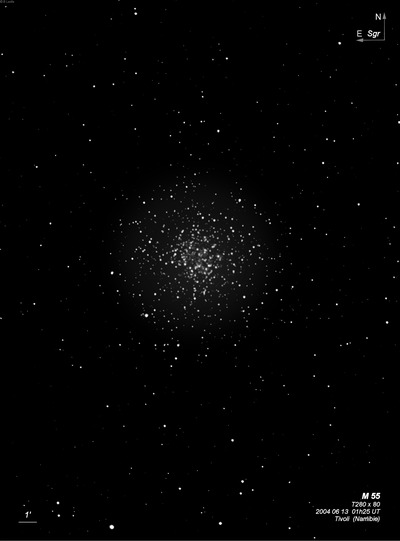
Nicolas-Louis de Lacaille discovered M55 = NGC 6809 = Lac I-14 = D 620 = h3798 in 1751-1752 during his expedition to the Cape of Good Hope. He used only a 1/2-inch refractor at 8x and described it as appearing "like the obscured nucleus of a big comet." Messier couldn't find it in 1764 but succeeded in 1778, describing it as "a nebula which is a whitish spot; extending for 6' around the light is even and does not appear to contain a star."
William Herschel mentions in Philosophical Transactions for 1818: "30 Jul 1783, small 20 feet telescope (12-inch). With 250 power fairly resolved into stars; I can count a great many of them, while others are too close to be distinguished separately. 1784, 1785, 20 feet telescope (18.7-inch). A rich cluster of very compressed stars, irregularly round, about 8' long."
James Dunlop described the cluster as "a beautiful, large round bright nebula, about 6' or 7' diameter, gradually condensed to the centre, easily resolvable." His position is 24' too far east. On 3 Aug 1834 (sweep 478), John Herschel recorded "Globular cluster; pB; vL; R; vglbM; diam in RA 30.0s; all resolved into separate st 13...16 m; not so comp M as to run together into a blaze or nipple. "
200/250mm - 8" (9/3/83): at 100x; faint stars resolved across entire disc, no compact core, over unresolved haze. Highly resolved at 165x.
300/350mm - 13.1" (9/3/83): bright, large, superb resolution of at least 75 stars mag 12 and fainter. Loosely compressed with a broadly brighter core, irregular background glow. One of the easiest resolved globulars.
400/500mm - 17.5" (7/14/99): at 100x this a beautiful, highly resolved cluster with outliers extending out to at least 12' in diameter. At 220x, there is uniform covering of easily resolved stars across the halo and the broadly concentrated core. In addition the central region is contains a layer of very faint stars over unresolved haze. The star density drops off rapidly in the outer halo and becomes very scraggly around the periphery. The core also seems indented on the SE side with a void in the halo on this edge.
600/800mm - 24" (9/2/16): at 200x; superb, very highly resolved showpiece globular of several hundred stars, spreading out at least 15' in diameter. Contains a very large, very bright core that is uniformly covered with similar, relatively bright resolved stars. The core has a loose appearance and doesn't increase to a nuclear peak. The central portion has a distinct 3-dimensional appearance with the brighter stars overlaying a second dense carpet of fainter stars against an unresolved background glow. The halo is very large and well resolved with a mix of brighter and fainter stars. The periphery of the halo is irregular or scraggly, but roughly symmetrical.
Notes by Steve Gottlieb